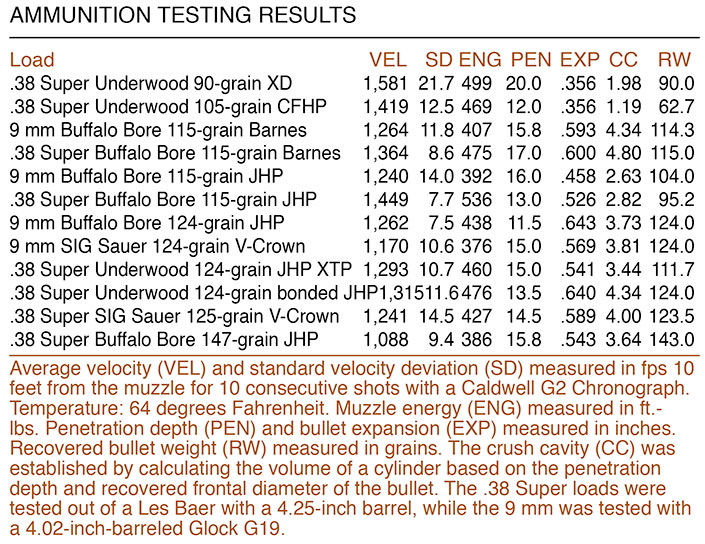
The Underwood .38 Super ammunition tested for this article performed exceptionally well. Underwood is an often-overlooked manufacturer of high-quality ammunition.
Many believe the .38 Super is a “magnum” 9 mm and that it’s significantly more effective from a terminal-performance standpoint. With common FMJ ammunition you can expect a .38 Super to generate about 10 percent more velocity and about 20 percent more kinetic energy. That sounds substantial, but does this increase in power translate to better terminal performance than what can be expected with a 9 mm when expanding projectiles are used for personal protection? I wanted to find out.
The .38 Super was introduced in 1929. It’s nothing more than the .38 Automatic (ACP) cartridge, designed by John Browning in 1900, loaded to higher pressures. The .38 ACP is loaded to a Maximum Average Pressure (MAP) of 26,500 psi and the .38 Super is loaded to a MAP of 36,500 psi. The .38 Super did not get the +P designation until 1974.
All .38 Super ammunition is considered +P ammunition. For a time, the Super was quite popular in IPSC competition because, when paired with custom-built 1911s and handloaded to even higher pressures, it met the major power factor. That, combined with larger-capacity guns for the time and the additional gas to make compensators work better, made .38 Supers great guns for the game.
Commercially, there are not a lot of defensive loads for the .38 Super. Buffalo Bore, SIG Sauer and Underwood were all I could find in stock. I tried matching .38 Super loads with similar 9 mm loads and fired them into blocks of Clear Ballistics gelatin.
The best apples-to-apples comparison was the 115-grain Buffalo Bore .38 Super +P and 9 mm +P+ Barnes TAC-XP loads. These bullets are almost velocity blind, meaning they tend to deform very similarly over a wide velocity range. The .38 Super was 100 fps faster and generated 68 additional ft.-lbs. of energy. It also penetrated 1.2 inches (8 percent) deeper and bullet deformation was almost identical.
With the 115-grain Buffalo Bore JHP .38 Super and 9 mm loads, the comparison was not as valid because of the different bullets used. The Super had a velocity advantage of 209 fps and an energy advantage of 144 ft.-lbs. But, the 9 mm load penetrated 3 inches (23 percent) deeper because the bullet did not expand as wide, and it retained more weight.
Another good apples-to-apples comparison would be the .38 Super and 9 mm loads from SIG Sauer. SIG loads the Super with a 125-grain V-Crown bullet and the 9 mm with a 124-grain V-Crown. The Super demonstrated a 6-percent advantage in velocity and a 13-percent advantage in kinetic energy. Still, penetration differed by only .5 inch and expansion by only .02 inch. The external ballistic advantage of the Super translated to an almost non-existent terminal-performance advantage.
Both of the Underwood .38 Super 124-grain loads performed similar to the .38 Super V-Crown load, one with less and one with a little more expansion. What was notable was they generated the highest velocity and energy of any of the 124-grain loads tested. On the other hand, the Buffalo Bore 124-grain JHP load expanded wider than any load tested from either cartridge. But, because of this it also penetrated the least. Velocity and energy are important, but this clearly highlights how critical the projectile is when it comes to terminal performance.
Two unconventional .38 Super Underwood loads were also tested. The 90-grain Xtreme Defense load utilizes a non-expanding, all-copper bullet with a dished-out nose. It sizzled out the barrel at 1,581 fps, generating the second-highest energy and deepest penetration of anything tested. The unique bullet in the 105-grain Controlled Fracturing hollow point load is designated to shed three petals upon entry. Each of these 14-grain petals radiated out in about a 6-inch pattern to a depth of about 6 inches. The 63-grain base of this bullet penetrated 12 inches.
I’ve become fond of using the calculated crush cavity—the volume of a cylinder based on penetration depth and expanded diameter—to evaluate the terminal performance or the potential for tissue destruction of a particular load. The largest crush cavity was delivered by the Buffalo Bore 115-grain TAC-XP .38 Super +P load; it was 10 percent larger than the next- closest contender, which was the 124-grain Bonded JHP .38 Super load from Underwood. Which one’s best? It’s hard to say. If you like penetration go with the Buffalo Bore load. If you like expansion, go with Underwood.
There’s something about the .38 Super that deeply appeals to me. However, even though the Super will shoot faster and hit harder than any 9 mm, the extra muzzle blast and recoil would seem to negate the minute increases in terminal performance. The .38 Super is cool, loud and powerful, but is it really a better all-around option for self-defense than 9 mm? Probably not.






































